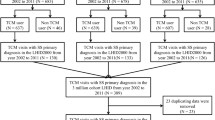Abstract
Objective
To analyze the composition rules of oral prescriptions in the treatment of headache, stomachache and dysmenorrhea recorded in National Standard for Chinese Patent Drugs (NSCPD) enacted by Ministry of Public Health of China and then make comparison between them to better understand pain treatment in different regions of human body.
Methods
Constructed NSCPD database had been constructed in 2014. Prescriptions treating the three pain-related diseases were searched and screened from the database. Then data mining method such as association rules analysis and complex system entropy method integrated in the data mining software Traditional Chinese Medicine Inheritance Support System (TCMISS) were applied to process the data.
Results
Top 25 drugs with high frequency in the treatment of each disease were selected, and 51, 33 and 22 core combinations treating headache, stomachache and dysmenorrhea respectively were mined out as well.
Conclusions
The composition rules of the oral prescriptions for treating headache, stomachache and dysmenorrhea recorded in NSCPD has been summarized. Although there were similarities between them, formula varied according to different locations of pain. It can serve as an evidence and reference for clinical treatment and new drug development.
Similar content being viewed by others
References
Meng QY. Development process about pain syndrome of traditional Chinese medicine theory. Shanghai J Tradit Chin Med (Chin) 1999;45(3):4–6.
Shen D, Tang SH, Lu P, Yang HJ. Analysis on composition principles of Chinese patent drugs containing Ginseng. China J Chin Mater Med (Chin) 2013;38:2027–2032.
Tang SH, Yang HJ. Review of study on TCM medication regularity. Chin J Exp Med Formul (Chin) 2013;19:278–282.
Wu JR, Zhang B, Yang B. Analysis on YAN Zheng-hua's medication rule in prescriptions for treating stomachache by apriori and clustering algorithm. Chin J Exp Med Formul (Chin) 2012;18(20):1–5.
Zhu YJ, Zheng K, Zhang Yi, Tang SH. Analysis on composition principles of external use prescriptions for urticaria from the Prescription of Traditional Chinese Medicine Dictionary. Chin J Exp Med Formul (Chin) 2012;18(18):1–3.
Tang SH, Lu P, Li J, Chen JX, Shen D, Yang HJ. Composition Principles of Prescriptions for Asthma in Dictionary of Chinese Medicine Prescription. J Tradit Chin Med (Chin) 2012;53:1230–1233.
Li J, Lu P, Zhang RX, Xin FR, Chen JX, Tang SH, et al. Analysis on composition principles of prescriptions for atrophic lung disease in the book of the Prescription of Traditional Chinese Medicine Dictionary. Chin J Exp Med Formul (Chin) 2012;18(10):1–5.
Yang HJ, Shen D, Tang SH, Lu P, eds. Prescription analysis of Chinese patent drugs. Beijing: People's Medical Publishing House;2014:2–22.
Lu P, Li J, Tang SH, Chen JX, Zuo XH, Liu X, et al. Development and application of traditional Chinese medicine inheritance support system. Chin J Exp Med Formul (Chin) 2012;18(9):1–4.
Li J, Lu P, Tang SH, Shen D, Chen JX, Yang HJ. Analysis on composition principles of prescription for lung abscess by using traditional Chinese medicine inheritance support system. Chin J Exp Med Formul (Chin) 2012;18:254–257.
Lu XH, Shan QW. Analysis on professor LU Shang-ling's prescription experience for intermittent headache by using traditional Chinese medicine inheritance support system. Chin J Exp Med Formul (Chin) 2012;18(9):5–8.
Sun JC, Wang YP. Analysis on Composition Principles of prescriptions for edema by using traditional Chinese medicine inheritance support system. Chin J Exp Med Formul (Chin) 2012;18 (10):11–14.
WU JR, Zhang B, Yang B, Chen D. Analysis on YAN Zheng-hua's medication rule in prescriptions on diarrhea based on apriori and clustering algorithm. Chin J Tradit Chin Med (Chin) 2013;28:2274–2277.
Author information
Authors and Affiliations
Contributions
Yang HJ designed the project, Shen D collected the data, cleaned it and made primary data mining via TCMISS, Tang SH made deep analysis on the data and wrote the paper.
Corresponding author
Additional information
Conflict of Interest
We declare that we have no financial and personal relationships with other people or organizations that can inappropriately infl uence our work, and there is no professional or other personal interest of any kind in any product, service and/or company that could be considered as influencing to the paper.
Supported by the National Nature Science Foundation of China (Nos. 81330086, 81203005), and the Fundamental Research Funds for the Central Public Welfare Research Institutes (No. ZZ070830)
Electronic supplementary material
11655_2017_2957_MOESM1_ESM.pdf
Supplementary material to “Analysis on Composition Rules of Chinese Patent Drugs Treating Pain-Related Diseases Based on Data Mining Method”
Rights and permissions
About this article
Cite this article
Tang, Sh., Shen, D. & Yang, Hj. Analysis on Composition Rules of Chinese Patent Drugs Treating Pain-Related Diseases Based on Data Mining Method. Chin. J. Integr. Med. 25, 861–866 (2019). https://doi.org/10.1007/s11655-017-2957-z
Accepted:
Published:
Issue Date:
DOI: https://doi.org/10.1007/s11655-017-2957-z




